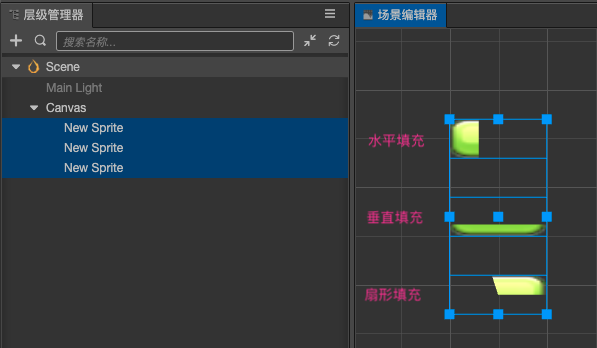Sprite Component Reference
Using Sprite is the most common way to display images in 2D/3D games. By adding the Sprite component to a Node, you can display SpriteFrame assets from project assets.
![]()
Add a Sprite component to the node by clicking the Add Component button below the Inspector panel and selecting UI -> Render -> Sprite.
To use Sprite, please refer to the Sprite API documentation and the Sprite scene of the test-cases-3d project.
Sprite Properties
| Property | Function Explanation |
|---|---|
| Type | Rendering mode, currently includes SIMPLE, SLICED, TILED, FILLED four rendering modes. |
| CustomMaterial | Custom Material, please refer to UI Custom Material |
| Src Blend Factor | The source image blend mode. |
| Dst Blend Factor | The destination image blend mode. Together with the above properties, you can mix the foreground Sprite and background in different ways to render, and you can refer to glBlendFunc Tool for an effect preview. |
| Color | Image color. |
| Size Mode | Specify the size of the Sprite.TRIMMED automatically fit to the size of the sprite croppedRAW automatic fit for sprite original size.CUSTOM use the node preset size. When the developer manually modifies Size properties, Size Mode will be automatically set to Custom. |
| Atlas | Auto Atlas which the Sprite display image asset belongs to. |
| Sprite Frame | Sprite Frame Assets which is used to render the Sprite. (The Edit button behind Sprite Frame is used to edit the 9-sliced cutting of the image asset, please refer to the Use a Sliced Sprite to make a UI image documentation. |
| Trim | Whether the transparent pixel area is included in the node bounding box. Please refer to the Auto Trim for SpriteFrame documentation. |
| Grayscale | If enabled, Sprite will be rendered in gray scale mode. |
After adding the Sprite component, drag the SpriteFrame type asset from the Assets to the Sprite Frame property reference. Then, the asset image can be displayed through the Sprite component.
If this SpriteFrame asset is contained within an Atlas asset, then the Atlas property of the Sprite will be set up along with it.
Note: to dynamically replace SpriteFrame, you need to dynamically load the image asset before you replace it, please refer to the Acquire and load asset: how to dynamically load documentation.
Rendering mode
Currently, the Sprite component supports the following rendering modes:
Simple mode: rendering the Sprite according to the original image asset. It is normally used along withUse Original Sizeto guarantee the image shown in the scene is in full accordance with the image designed by the graphic designer.Sliced mode: the image is cut up into a 9-slicing and according to certain rules is scaled to fit freely set dimensions (size). It is usually used in UI elements or to make images that can be enlarged infinitely without influencing the image quality. It will cut up the original image into a grid to save game asset space. Please read Use a Sliced Sprite to make a UI image for details.Tiled mode: The image will be repeated to fit the size of the Sprite. If the SpriteFrame is 9-sliced, the corners will also remain unscaled while the other areas will be repeated.
Filled mode: draws a portion of the original image in a certain direction and scale, based on the origin and fill mode settings. Often used for dynamic display of progress bars.
Filled mode
When the Type property selects FILLED, a new set of properties appears to be configured. So let's explain their roles in turn.
| Property | Function Explanation |
|---|---|
| Fill Type | Fill type selection, including HORIZONTAL, VERTICAL, and RADIAL. |
| Fill Start | Normalized values for filling starting position (from 0 ~ 1, denoting the percentage of total population), when you select a horizontal fill, the Fill Start is set to 0, and it is populated from the leftmost edge of the image. |
| Fill Range | Normalized values for padding ranges (same from 0 ~ 1). When set to 1, it fills up the entire range of the original image. |
| Fill Center | Fill center point, this property can only be modified if the RADIAL fill type is selected. Determines which point on the Sprite is used as pivot when the FillType is set to RADIAL. |

Fill Range Supplemental description
Under both the HORIZONTAL and VERTICAL fill types, the values set by Fill Start affect the total number of fills, if Fill Start is set to 0.5, even if Fill Range is set to 1.0, the actual padding is still only half the total size of the Sprite.
The Fill Start in the RADIAL type only determines the orientation of the starting fill, when Fill Start is set to 0, start filling from the x axis positive direction.
Fill Range determines the total amount of padding, which fills the entire circle when Fill Range is set to 1. A counter anticlockwise fill when Fill Range is positive, and is filled clockwise when negative.